HOn3
Posted
#260860
(In Topic #14235)
Full Member
Dabbling in Canadian narrow gauge
Hi All,I meant to start this topic earlier this year, but COVID-19 and its long-term consequences got in the way. Back to reasonably normal health now, so on with the circus.
I became interested in small scale narrow gauge (again) quite recently, sufficiently so to start making some plans for a small inglenook plank-type layout. It all started from my HO interest, the Great Northern Railway (GN - the US one) and a section in Montana around Conrad, a small prairie town. Research showed that this stretch of the GN started life as a 3-foot gauge railway built in the 1880s-1890s between Great Falls, Montana, and Lethbridge, with its primary aim the shifting of coal. Further research identified the yard at Lethbridge as being of considerable modeling interest - dual gauge track, turntable, roundhouse, coal mines with narrow gauge/standard gauge tracks, long cable inclines, and some potentially interesting real-life inglenooks involving standard and narrow gauge track. Far too much for a small plank, but enough potential cameos to keep me occupied for a fair while. And I get to have some Canadian Pacific Railway standard gauge stock. Bonus.
To keep any layout a reasonable size for the apartment, I decided to go with HOn3 (HO scale running on scale 3-foot gauge track, not to be confused with HOn30, where the track is bog-standard N-gauge and that often uses out-of-scale N-scale chassis). I've modeled in OO9 and On30 before, narrow gauge is nothing new. And this is where the fun starts. HOn3 locomotives are few and far, and most are based on Western US narrow gauge lines such as the Denver and Rio Grande (D&RG). Not too much use in the prairies of Canada. Add to that there is currently only one RTR manufacturer that produces a very limited range of D&RG models every 2-3 years. The other source is old brass, dating from the mid 1960s to the early 1980's. Great bodywork and detailing, the mechanisms often lead a lot to be desired. The price range for these old brass coffee grinders is in the $300-$1000 range, and a new RTR in plastic currently goes for $500-$650 second hand.
I recently bit the bullet and acquired a second-hand HOn3 D&RG C-16 class 2-8-0 (a "Consolidation" over here) to get things moving. Some research showed the model was built in the early 1970s. With a bit of work (hopefully that is not a forlorn hope) it will look like something running around Lethbridge in the 1890s. Great bodywork for the D&RG but not exactly how the Baldwin Locomotive Works built them for Canada.* A re-motoring kit is only around $100 with postage, plus another $50 worth of various brass bits for the body work changes. Still, should come in at around $550 with a sound decoder thrown into the mix. I also need some 2-6-0 Moguls, an 0-6-0 shifter (shunter), and a 4-4-0 American to complete the roster, they will be a lot more challenging than the Consolidation.
That's it for now. The next post will cover some specific history, why and how it will get a new motor.
Nigel
*Baldwin was a significant US locomotive manufacturer that exported world-wide, railroads usually selected locomotives from the latest catalog and had them modified to their individual requirements. That's why a Consolidation from one railroad looked pretty much like those of another railroad. I recently went through the Baldwin order book specifications for the 1880s and 1890s, it's amazing how similar the locomotives ordered by various companies were. Most railroad locomotive works existed for service and repair, not construction.
©Nigel C. Phillips
Posted
Full Member
It’s so good to hear from you again, particularly after having to recover from covid complications, so a very warm welcome back.
Your new direction is an interesting one and as usual, you’re not be holding back to achieve true fidelity to prototype. Bon courage mon ami and I know you’ll take the complications in your stride, whilst enjoying the challenge. I’ll be following your loco building with interest, before continuing with my modest kit efforts. I’ve also taken the plunge in acquiring a second hand part completed kit in the form of a 517 Class which should be fun.
Best,
Bill
 Last edit: by Longchap
Last edit: by Longchap
At 6'4'', Bill is a tall chap, then again, when horizontal he is rather long and people often used to trip over him! . . . and so a nickname was born :)
Posted
Full Member
So good to hear from you again…..you have been missed!
I do hope you are fully recovered from Covid complications. Like Bill, I look forward to following the progress of your new project
Best wishes
Posted
Full Member
Thanks,
Not quite 100% but getting there.
Nigel
©Nigel C. Phillips
Posted
Full Member
Some photos of the 2-8-0, and some of the issues that this old coffee grinder has (not that this one is anywhere near noisy when running thanks to a nylon/delrin intermediate/idler gear).
The 2-8-0 attached to the tender. Total length 7.5". Like most brass models from the 1970s and 1980s it has a coat of gold-finish lacquer. Hence the lack of tarnishing. Apparently there is no need to prime, just a wash to remove any grease from fingers. That tender looks like an oil one, needs backdating to coal.
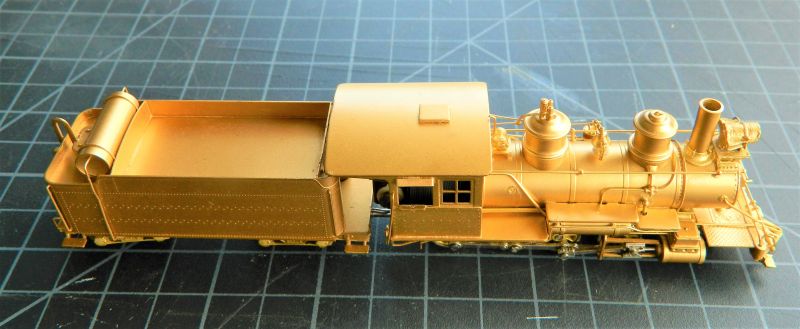
The locomotive in more detail. From left to right on the boiler are: Steam turbine generator, steam done, bell, sand dome, smokestack, electric headlight. This is what a 2-8-0 had in the 1930s. The generator has to go. The steam and sand domes are a bit too modern as well. Screwed, not soldered on, so hopefully easily removed. The headlight is wrong for what I need, which is a big, square, coal oil headlight.
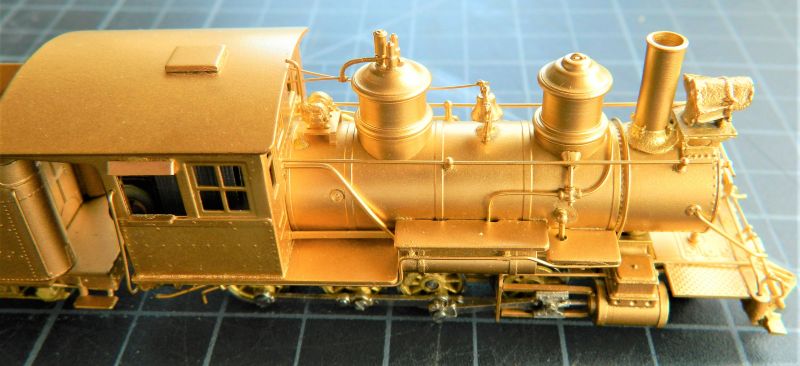
The "big" problem - a very large 5-pole KTM motor sits in the cab. No cab detailing, no firebox, and no backhead. Bit of a "sore thumb" issue. The draw bar is the electrical pickup from the tender to the motor. I have seen some modelers install "canvas" curtains around the cab overhang to hide the motor, very prototypical for 2-8-0s in colder climes. If I run into issues on the remotoring I may go that route, as it currently rolls smoothly on DC at around 3v with minimal cogging(12"/30.5cm minute). Top speed for the prototype was around 35mph, so conversion to DCC and an adjusted speed table would be ideal. To do that though the motor would have to isolated from the chassis. Which means the bottom and the mounting screws.
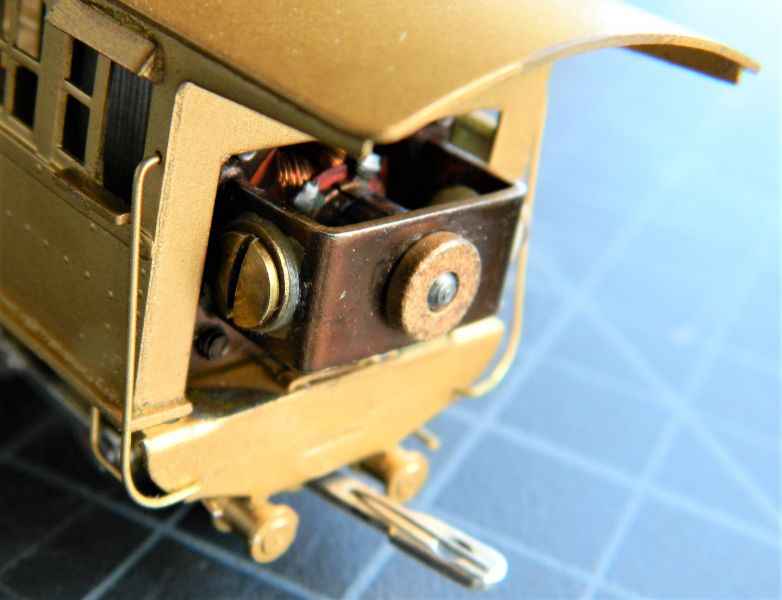
Under the hood. A straightforward worm and idler gear arrangement. The intermediate/idler gear is not fixed to its shaft but is located with brass washers either side. There is a bit of play but not enough to justify replacement yet. The plan is to ditch the motor and replace with a smaller one that fits inside the cab. That will need a new worm as well, as the one shown is proving nigh-on impossible to get off as my gear-puller won't fit. I suspect it was heat-shrink on. There is less than 20mm of space in the cab, which limits what motor will fit. The KTM motor has way too much torque, the back of the locomotive moves to the side when starting off too fast. Those 2 middle flange-less drivers are prototypical for a Baldwin 2-8-0.
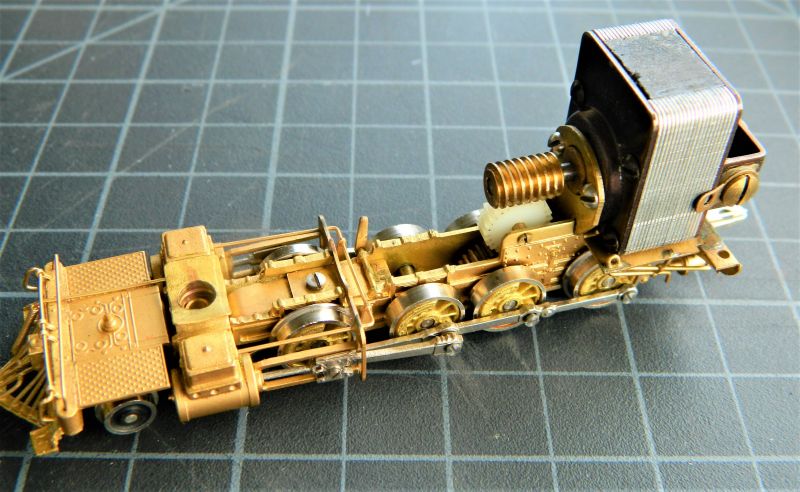
Side view of running gear. Electrical pickup is "American", one side from the drivers (the body shell is live), the other side from the tender (the tender body is live). I am undecided at this point whether to have pickups on both sides of the locomotive, or to bite the bullet and go dead rail. I done DCC conversions of this type of pickup in the past without any issues.There are are etched representations of brakes and hangers, as well as cast brake cylinders: according to the Baldwin work order the 1890 prototype for the line I'm modeling did not have brakes supplied. I would hope they were installed at the railway works on delivery, as cattle wandering across the line in combination with icy rails lead to major derailments.
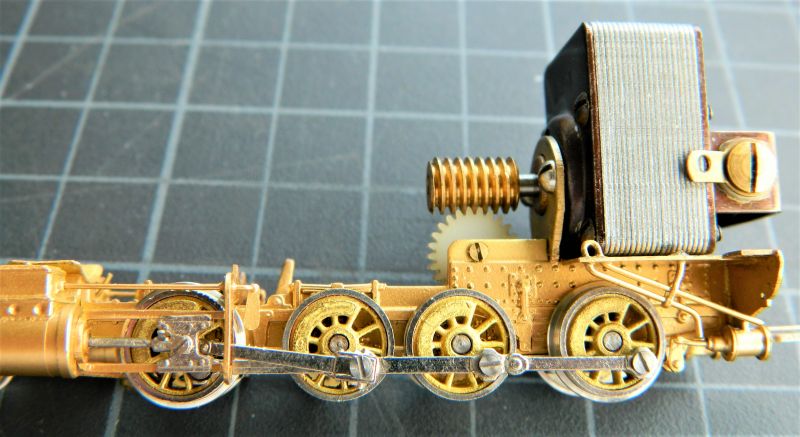
A fairly straightforward modification to get this back to what it looked like in the 1890s. (I hope that's not coming back to bite me). So, time to find some cast brass bits and sort out the motor and worm.
Nigel
©Nigel C. Phillips
Posted
Full Member
Looking forward to updates Nigel - on the loco, layout and health. :cheers
'Petermac
Posted
Full Member
Some (long) background on the project and how things are moving along (slowly):
The Alberta Lines.
I decided to call the planned layout the “Alberta Linesâ€, a phrase coined by Omar Lavallée in his book entitled Narrow Gauge Railways of Canada (1972, out of print). The Alberta Lines describe a collection of railway companies in what is now southern Alberta and northern Montana in the years 1885 through 1912. They comprised the founding North Western Coal and Navigation Company (NWC&NC), and its subsidiaries the Alberta Railway and Coal Company (AR&CC), the St. Mary’s River and Railway Company (SMRRC), and the Great Falls and Canada Railway (GF&CR). Originally 3-foot gauge, the lines were converted to dual and then to standard gauge by 1912. The NWC&NC Lethbridge-Dunmore junction line was leased to the Canadian Pacific Railway (CPR) in 1893, when much of its original locomotive stock was sold. All of the lines were leased to the Canadian Pacific Railway (CPR) for 999 years in 1912. The narrow-gauge system at its maximum had 370 miles of track. See Map 1 for the routes of the lines.
Map 1.
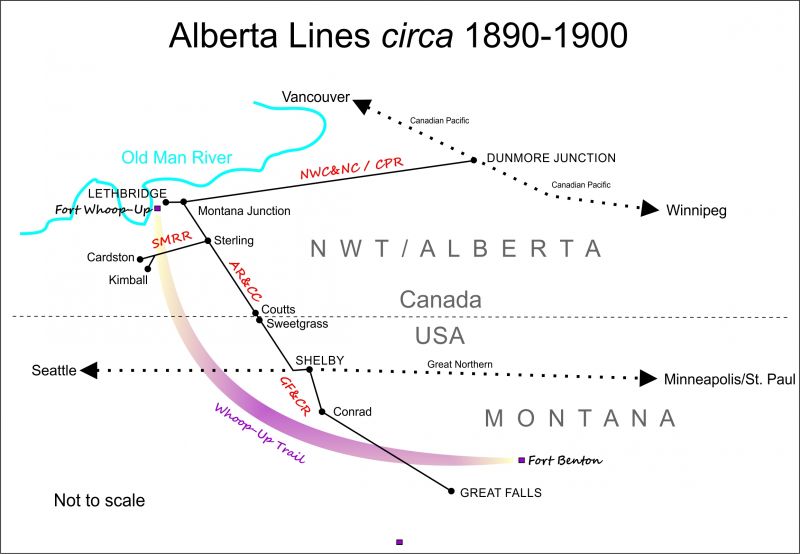
The lines were built to exploit the coalfields around what is now Lethbridge, Alberta. The NWC&NC was incorporated in 1882 in Britain and 1884 in Canada by Sir Alexandra Tilloch Galt. Coal had been mined in southern North West Territories (Alberta from 1905) since the 1870s, and with the arrival of the CPR, there was a ready customer, albeit some 130 miles away. After a failed attempt to move coal by river in 1884, the NWC&NC laid a line from Coalbanks, on the banks of the Old Man River, to Dunmore Junction for transfer to standard gauge cars. Not very efficient (mining cars to narrow gauge cars to standard gauge cars), but some 90,000 tons of coal a year were being transported by the 1890s. There were in total 8 Galt-owned coal mines in and around the city of Lethbridge, mining ending in 1957 with the demise of steam engines.
Coal also went to Great Falls, Montana via the AR&CC in Canada and the GF&CR in Montana. The AR&CC/GF&CR line opened in 1890, and was transporting coal, passenger and regular freight traffic. The GF&CR was bought by the Montana & Great Northern Railway in 1901 (a subsidiary of the Great Northern Railway) to prevent the CPR from entering the USA, and converted to standard gauge through 1902. It must have been dual gauged during the transition. The line followed the path of the Whoop-Up trail, an important trading route between Fort Benton, Montana, and Fort Whoop-Up, Canada (fort in this case being trading post). The trail was moving some 1.7 million tons of goods a year by ox-drawn carts in the 1880s, taking some 10-14 days for the journey. The AR&CC and GF&CR were doing this in less than 24 hours and in all weathers. Why Great Falls? Great Falls was a copper and silver smelting center, workers and industry needed coal, and the local coal mines were failing in the late 1880s. The coal from Lethbridge was of superior quality, and cheaper to import, than coal from the eastern US coalfields.
The late 1890s to early 1900s offers a lot of interest when modeling the lines around Lethbridge. Narrow- and standard-gauge traffic east to Montana Junction and Dunmore Junction on dual gauge track, narrow gauge AR&CC, GF&CR and CPR locomotives in the yard and on the turntable, coal, cattle, regular freight, and passenger stock being moved around. And there is that that steep incline down the banks of the coulee to where coal was brought up from the river bank drift mines, and a regular coal mine next to the yard with dual-gauge tracks.
The photograph shows what the yard in Lethbridge looked like in the 1890s when it was shared by the CPR and the AR&CC. Looking west towards the turntable and roundhouse the lines going to the mining car incline and mine car/narrow gauge cars interchange are to the left of the water tower, double and single gauged tracks to the turntables, stub-ended points, and the repair shops to the right.
Photograph 1. Lethbridge yard in the 1890s. Courtesy of the Galt Museum, Lethbridge.There are 2 water towers, one behind the other.
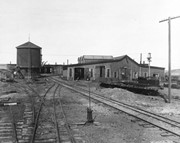
Map 2 is a composite layout plan derived from contemporaneous fire insurance maps (1891-1910) and gives a good idea of where the various yard buildings and structures were. The jog on the roundhouse was presumably to accommodate the longer standard gauge CPR locomotives. Given the diameter of the turntable 70-feet) these would have been 2-6-0 Moguls. I also superimposed how much a 12 x 2-foot layout (3 modules, 3, 5, and 2 feet) would actually cover. Hmm. Definitely a “well I never!†moment. Time to start being selective and choosing the cameos.
Map 2.
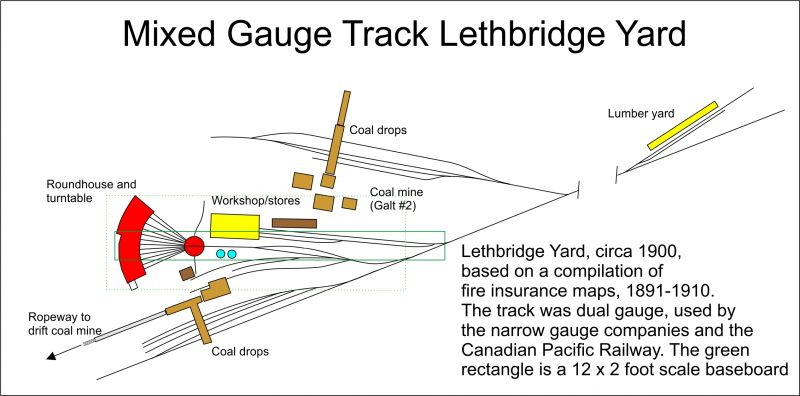
I am not going to be able to model all of this in the space available to me without some compression and shortening. I think a representation of the yard will be first. And of course, that incline down to the river and the drift mines at the bottom deserves modeling at some stage. So that’s what I shall be doing over the next little while. I am sure a fair amount of scratch building of rolling stock and track, along with modification of RTR narrow gauge locomotives to backdate them to the late 1890s will be required. Should be interesting.
Nigel
Notes: A lot of research, nearly all of it online because of COVID-19, was required, and was a great learning process. Narrow Gauge Railways of Canada by Omar Lavallée describes the many narrow-gauge lines that were to be found in Canada. Out of print, but can be found secondhand. The Galt Museum in Lethbridge and the McCord Museum in Montréal both have online collections covering the development of the coal mining industry around Lethbridge. The DeGolyer Library, Southern Methodist University in Dallas, TX, has an excellent online data base of Baldwin Locomotives (order specifications, erection diagrams). The National Assurance Co./Chas. Gould Co. fire plans for Lethbridge were used for the yard schematic.
 Last edit: by BCDR
Last edit: by BCDR
©Nigel C. Phillips
Posted
Full Member
Posted
Full Member
Thanks. The reality of course is fitting what I would like in a plank space. HO narrow gauge takes pretty much the same space as HO or OO. Really needs a 20 x 40 foot basement to get it all in. Time to get slicing and dicing.
Nigel
©Nigel C. Phillips
1 guest and 0 members have just viewed this.

